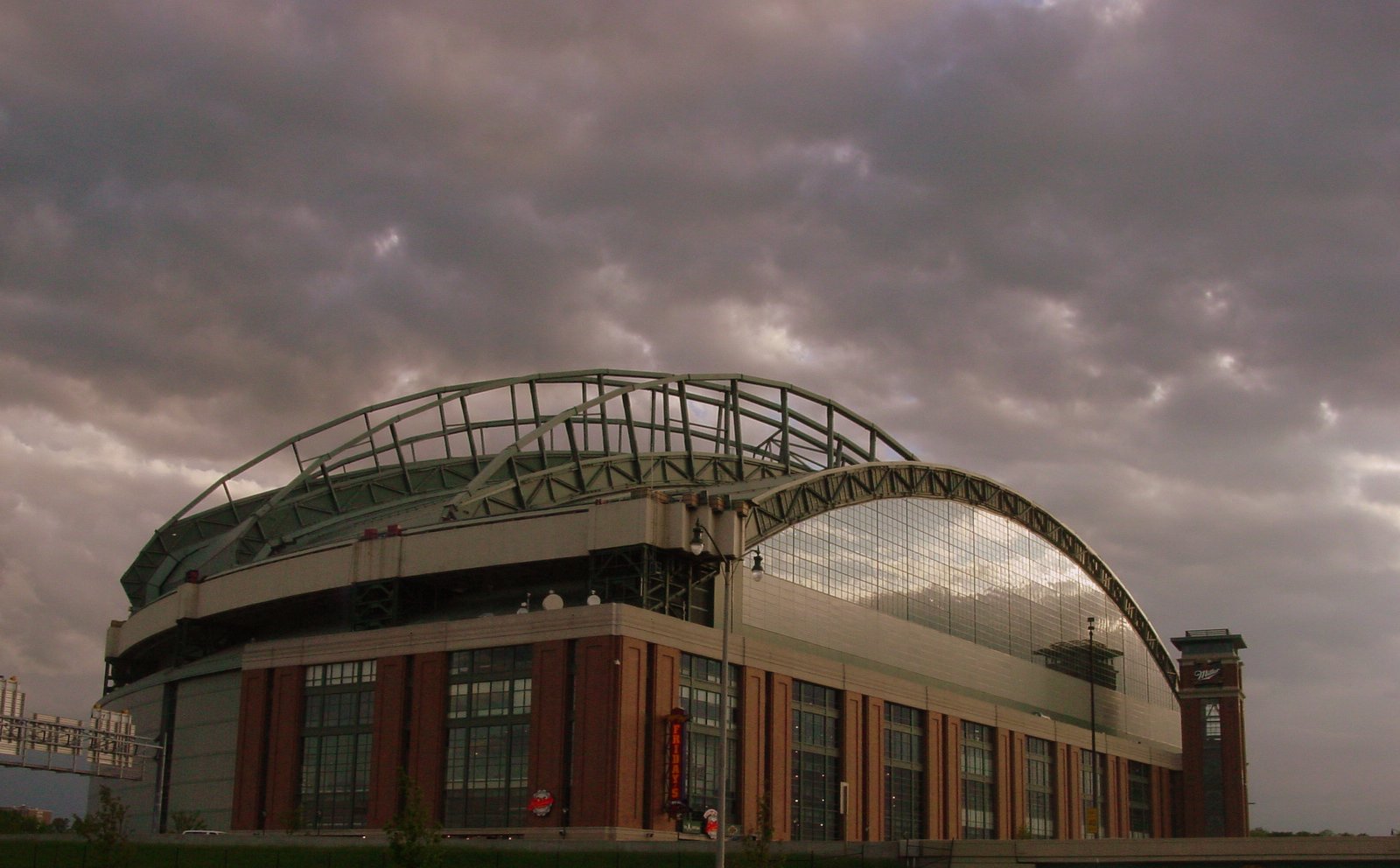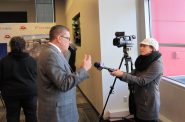Why Brewers Stadium Conflict Erupted
Legislature has squeezed the five-county ballpark district, leaving it less flexibility.

American Family Field. Photo by Jeramey Jannene.
Years ago, a source close to the Southeast Wisconsin Professional Baseball Park District, the government entity which oversees the tax giveaway to the Milwaukee Brewers stadium, predicted the sales tax funding the ballpark would never sunset. “The reality is the funding will never end,” the source told Urban Milwaukee, because there will always be maintenance costs, repairs and upgrades the team wants subsidized.
When the law funding the new stadium was passed, the early discussion suggested the five-county sales tax would end in 14 years, in 2010. That was moved back to 2014 and then 2018, with no end in sight. Finally state legislators had had enough and passed a law, signed by Gov Tony Evers in November 2019, which required that the tax must sunset by August 31, 2020.
“Putting the final punctuation” on the tax “is very important to my assembly district,” Rep. Robert Wittke (R-Racine) told the Legislature. “Residents of Racine County have never been happy they were included in the stadium tax. Increasingly, residents in the other surrounding counties have asked why the sales tax has not yet ended.”
State Sen. Tim Carpenter (D-Milwaukee) noted he had previously voted against the Senate confirmation of appointees to the baseball district board “to show my displeasure that the five-county tax was not going to end as promised.”
The original legislation creating the stadium district board seemed designed to distance it from the local taxpayers. The five counties being taxed were only given seven of the 13 appointments to the board, with the rest appointed by Wisconsin’s governor. Waukesha, Ozaukee, Washington and Racine Counties each got only one appointment, while Milwaukee County got two and the City of Milwaukee one. The district’s website offers no contact information for the 13 board members and the minutes of meetings are often very brief, with the board meeting in private to discuss a long list of concerns, including “the investment of public funds.”
The legislators’ skepticism that the ballpark district would continue to drag its feet was reinforced by the fact that its executive director, Mike Duckett, testified against the law in 2019, arguing it would “limit the District’s ability to collect enough revenue to pay its outstanding debt obligations, or to place enough funds in escrow to meet future debt payments.”
By then the ballpark district already knew it had major future costs that needed to be funded. The M.A. Mortenson company had been hired in December 2018 to do a study of all projected needs for replacement of any stadium features or equipment until the years 2040. These included:
-replacement of two 800-ton chillers in 2025 and 2030 and new air-handling equipment in 2028;
-short-term and long-term maintenance and upgrades of 9 elevators and 10 escalators;
-parking lot and roadway improvements, including full replacement of all parking area asphalt and concrete curbs;
-replacement of the flat roof portion of the ballpark;
-major equipment and control system work related to the retractable roof components, including “maintenance and replacement of cylindrical bearing assemblies, expansion bearing assemblies, wheel assemblies, rail support system, buffers, bogie motor drives, and PLC roof control system.”
-“demolition and disposal of all existing sports lighting, supply and install of new LED lights and theatrical controls, final aiming and commissioning of the lighting system, and a 10-year parts and labor warranty”;
-full replacement of the LED Ribbon Board and LED Out of Town Scoreboards, and “one more replacement of these boards 10-15 years after this replacement.”
-a “drastically improved” sound system, including “full replacement of the existing seating bowl audio system including a multi-zone system with upgrade DSP, amplifiers, and electronic distribution equipment.” The upgrade also “adds additional speakers to fill in poorly covered areas, and upgrades amplifiers and signal processing equipment.”
-“a full replacement of all 35,244 seats” in the ballpark.
Mortenson concluded the district’s estimated cost of $71.7 million for this, based on earlier analysis by outside experts, was “reasonable,” but recommended the district included 15-20% more, “or between $10.7 million and $14.3 million,” to allow for “unforeseen or unexpected conditions and inflationary impacts that might arise.”
Yet Rick Schlesinger, the Brewers’ president of business operations, would later claim this report was not a“comprehensive” analysis.
The district made sure it had collected enough sales taxes to underwrite all of this prior to sunsetting the tax. That was a key reason the sales tax was dragging on longer than legislators wanted. “The Mortenson report was used by the board at that time to help determine the funds necessary to meet the District’s obligations,” says Pat Goss, who succeeded Duckett as executive director last year.
“If the Brewers had any concerns, they kept it to themselves. They had more than adequate time to pursue this with the board,” Thomsen adds. “If there were any concerns with the numbers they certainly should have been raised a long time ago.”
But Schlesinger now says the board declined to do a study of future costs with a company the team preferred. Precisely when he asked for this is not clear, but board members may have been concerned about approving a joint study, as the board is supposed to be representing taxpayers, not simply acceding to anything the team wants.
So the Brewers, by themselves, hired Brentwood, Tennessee-based Venue Solutions Group to do an assessment. That work was suspended in 2020 due to the pandemic, but is now expected to be finished by this summer.
But the legislation ending the sales tax — which the Brewers did not publicly oppose — could make that very difficult to achieve. The lease runs until 2030 and then gives the team options to extend it until 2040. Schlesinger is clearly hinting that some other way to subsidize the team must be found by 2030, even before the report by its consultant specifies what new costs have or will arise.
And though he never mentioned it, this clause may have been the real reason Duckett opposed the state legislation sunsetting the tax, as it would leave no way to assure the stadium remains “state of the art.”
Neil deMause, who has done the informative Field of Schemes blog for many years, makes clear the stakes for cities who sign such a clause: “This kind of clause was all the rage in the late ’90s, and is best remembered for the Cincinnati Bengals’ clause requiring the public to install holographic replay systems, if they’re ever invented. A similar clause ended up allowing the St. Louis Rams to break their lease and move to Los Angeles, after a ruling that the city would have to spend $700 million on stadium upgrades to keep the then 18-year-old stadium ‘first class’; and the Tennessee Titans owners are currently seeking $300 million in public cash on the basis of a similar clause.”
In short, the Brewers can threaten to abandon Milwaukee unless taxpayers step forward to start subsidizing the team. The initial bill, courtesy of a Tennessee company, will arrive this summer.
Murphy's Law
-
The Last Paycheck of Don Smiley
 Dec 17th, 2025 by Bruce Murphy
Dec 17th, 2025 by Bruce Murphy
-
Top Health Care Exec Paid $25.7 Million
 Dec 16th, 2025 by Bruce Murphy
Dec 16th, 2025 by Bruce Murphy
-
Milwaukee Mayor’s Power in Decline?
 Dec 10th, 2025 by Bruce Murphy
Dec 10th, 2025 by Bruce Murphy


















It was inappropriate to make the taxpayers pay for the giant Bud Selig bronze statue at Miller Park. Then we got stuck with the bill for a 1,400 square foot 3-D holographic shrine called “The Bud Selig Experience” where taxpayers can worship a 3-dimensional holographic Selig inside a reproduction of his old Milwaukee County Stadium office.
Brewers’ president of business operations Rick Schlesinger conceived the idea for the “Bud Selig Shrine” during a visit to the Abraham Lincoln Presidential Library and Museum, where he was “mesmerized” by a multimedia exhibit depicting Lincoln’s life. Schlesinger learned that it had been developed by BRC Imagination Arts, which then worked with Bud Selig to develop a show that builds to a 3D encounter with Selig himself, inside an authentic reproduction of his County Stadium office. It uses a technology found in only a handful of exhibits around the world.
Bud Selig receives a $6 million dollar per year pension from Major League Baseball, which is heavily subsidized by taxpayers.
https://grantland.com/the-triangle/the-3-d-bud-selig-experience-a-real-thing-that-is-actually-happening/
https://mlb.nbcsports.com/2014/12/19/bud-selig-will-get-a-6-million-a-year-pension-which-is-obscene/
Milwaukee Brewers 2021 payroll salaries–
Lorenzo Cain: $17 million.*
Christian Yelich: $14 million.
Avisáil García: $10.5 million.
Kolten Wong: $7 million (plus $1M signing bonus).
Josh Hader: $6.675 million.
Jackie Bradley Jr.: $6.5 million.
Brandon Woodruff: $3.275 million……….
Perhaps the collection plate should begin with Milwaukee Brewer management and organization before demanding subsidy from taxpayers,
Anyone else remember Tommy Thompson’s motorcycle caravan to the Wisconsin hinterlands in the mid-90’s, exhorting the denizens along the way to “stick it to ’em,” meaning the stadium tax for the Southeastern Wisconsin counties? And he ultimately got his way. We got stuck royally. And will be in the future. Ask George Petak how that worked out. And Tommy? That potential run for governor? Don’t even think about it.
Perhaps Bud Selig should leave his estate to the Southeast Wisconsin Professional Baseball Park District.
The Braves moved out of a stadium that was 20 years old.
Cobb County residents are losing $15m a year on Braves stadium, comprehensive study finds
https://tinyurl.com/yddtgzch